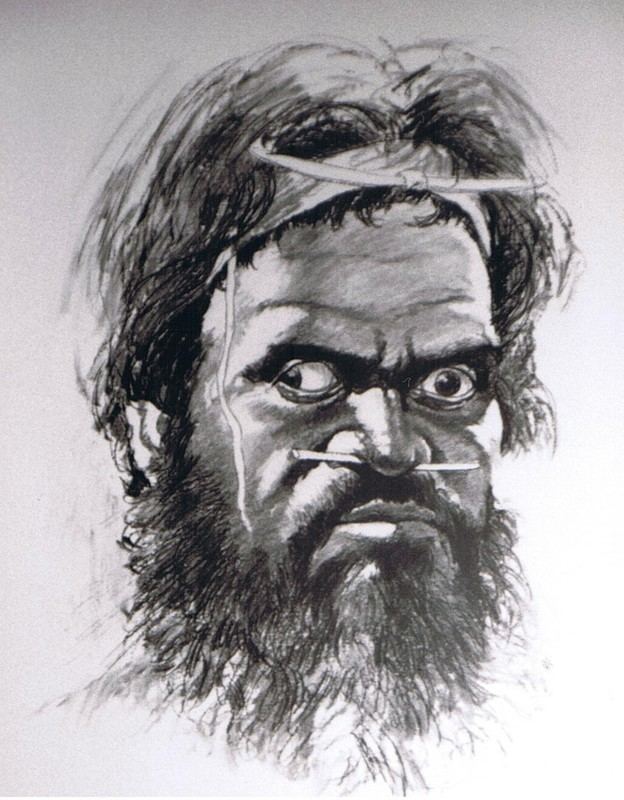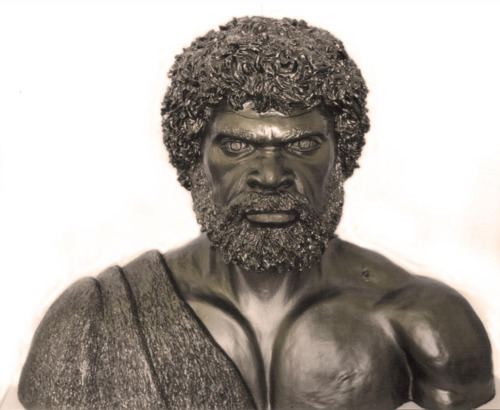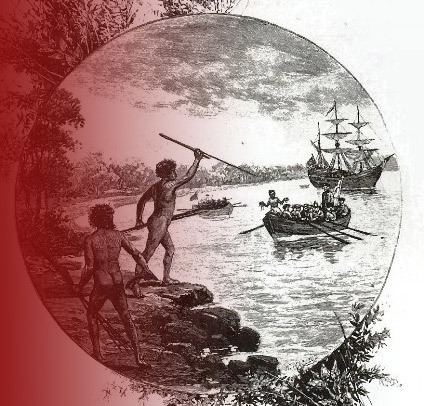Died June 2, 1802 | Name Pemulwuy Pemulwuy Occupation Political leader Ethnicity Aboriginal Australian | |
 | ||
Other names Pimbloy, Pemulvoy, Pemulwoy, Bimblewove, Bumbleway Similar People | ||
Hydromedusa pemulwuy
Pemulwuy (also known as, Pimbloy, Pemulvoy, Pemulwoy, Pemulwye) (c. 1750 – 2 June 1802) was an Aboriginal Australian man born around 1750 in the area of Botany Bay in New South Wales. He is noted for his resistance to the European settlement of Australia which began with the arrival of the First Fleet in 1788. He is believed to have been a member of the Bidjigal (Bediagal) clan of the Eora people.
Contents
- Hydromedusa pemulwuy
- Aboriginal housing company part 1 4 ahc pemulwuy waam
- Origin of Conflict Spearing of McIntyre
- Governor Phillips Military Expeditions
- Resistance
- Encounter with Black Caesar
- Battle of Parramatta
- Escape
- Death
- Anatomy
- Skull
- Legacy
- References

Pemulwuy was a member of the Bidjigal people, who were the original inhabitants of Toongabbie and Parramatta in Sydney. He lived near Botany Bay. Pemulwuy became a kadaicha man of his tribe. Pemulwuy would hunt meat and provide it to the food-challenged new colony in exchange for goods. However, in 1790 Pemulwuy began a twelve-year guerilla war against the British, which continued until his death.

When Pemulwuy grew into manhood he became Bembul Wuyan, which represents "the earth and the crow". According to historian Richard Green "he wasn't very impressed with the mix of cultures. He preferred that we stayed within our own peoples." Another name for him was "Butu Wargun" which means "crow".

Aboriginal housing company part 1 4 ahc pemulwuy waam
Origin of Conflict: Spearing of McIntyre

On 9 December 1790, a shooting party left for Botany Bay, including a sergeant of marines and three convicts, including Governor Phillip's gamekeeper John McIntyre. According to Watkin Tench:
About one o’clock, the sergeant was awakened by a rustling noise in the bushes near him, and supposing it to proceed from a kangaroo, called to his comrades, who instantly jumped up. On looking about more narrowly, they saw two natives with spears in their hands, creeping towards them, and three others a little farther behind. As this naturally created alarm, McIntyre said, “don’t be afraid, I know them,” and immediately laying down his gun, stepped forward, and spoke to them in their own language. The Indians, finding they were discovered, kept slowly retreating, and McIntyre accompanied them about a hundred yards, talking familiarly all the while. One of them now jumped on a fallen tree and, without giving the least warning of his intention, launched his spear at McIntyre and lodged it in his left side. The person who committed this wanton act was described as a young man with a speck or blemish on his left eye. That he had been lately among us was evident from his being newly shaved.
The group was pursued by the settlers with muskets, but they escaped.
McIntyre was taken back to the settlement, gravely wounded. Tench suspected that McIntyre had previously killed Aboriginal people, and noted the fear and hatred that the Aboriginal people, including Bennelong (an Aboriginal man who Governor Phillip had captured, in hopes of interaction with the Aboriginals) showed towards him.
"The poor wretch now began to utter the most dreadful exclamations, and to accuse himself of the commission of crimes of the deepest dye, accompanied with such expressions of his despair of God’s mercy, as are too terrible to repeat," wrote Tench of McIntyre. The gameskeeper died on 12 December. Before then, Colbee and several other aboriginals, came in to see the body. "Their behaviour indicated that they had already heard of the accident, as they repeated twice or thrice the name of the murderer Pimelwi, saying that he lived at Botany Bay," wrote Tench".
Several historians believe it is likely Pemulwuy killed McIntyre for payback.
Governor Phillip's Military Expeditions
An irate Governor Phillip ordered Lieutenant Tench to gather his company of marines and lead an expedition against the Bidjigal in retaliation for Pemulwuy's attack on McIntyre. He ordered that two Bidjigal were to be captured and ten killed; these ten were then to be beheaded and the heads returned to the settlement. Tench swiftly suggested an alternative and less bloodthirsty plan, that six Bidjigal be captured and brought to Sydney Cove but that none be killed out of hand.
Tench's proposal was accepted, and the expedition set out on 14 December in search of Pemulwuy and the Bidjigal tribe. The expedition was the largest military operation since the founding of the colony, comprising Tench, Lieutenants William Dawes and John Poulden, and 46 marines. However, despite three days of searching there was no sign of the Bidjigal. On 17 December Tench ordered a return to Sydney Cove to gather supplies.
The Aboriginal people present in Sydney refused to assist in tracking, with Colbee feigning injury.
A second expedition set out in the late afternoon of 22 December, comprising Tench and 39 marines. Tench unwisely decided to march at night in the hope of surprising the Bidjigal in their camp, and at sunset his company forded the Cook's River and continued south towards Wolli Creek.
The waterway was reached at 2.15am but the majority of marines seeking to cross it became stuck in mud along its banks. Tench himself was trapped waist-deep in the mud and had to be pulled to land on the end of a tree branch. A stock-take of equipment subsequently showed around half of the company's muskets had become unserviceable from exposure to the mud and water. After a few hours rest on the riverbank Tench abandoned the expedition, and the bedraggled marines again made their way back to Sydney Cove.
The expeditions having failed, it was decided to instead avenge McIntyre by strictly punishing any Aboriginal considered to have transgressed against the settlement's laws. In late December a marine detachment opened fire on two Aborigines who were seen removing potatoes from a settlement garden. One, named Bangai, was wounded and later found dead.
Resistance
Pemulwuy persuaded the Eora, Dharug and Tharawal people to join his campaign against the newcomers. From 1792 Pemulwuy led raids on settlers from Parramatta, Georges River, Prospect, Toongabbie, Brickfield and Hawkesbury River. His most common tactic was to burn crops and kill livestock.
Captain Paterson sent a search party to find him but was unsuccessful.
In May 1795, Pemulwuy or one of his followers speared a convict near present-day Chippendale.
Encounter with Black Caesar
In December 1795, Pemulwuy and his warriors attacked a work party at Botany Bay which included Black Caesar. Caesar managed to crack Pemulwuy's skull and many thought he had killed him, but the warrior survived and escaped. But this critically injured him afterwards.
Battle of Parramatta
In March 1797, Pemulwuy led a group of aboriginal warriors, estimated to be at least 100, in an attack on a government farm at Toongabbie.
At dawn the next day troops and settlers followed them to Parramatta. When confronted, Pemulwuy threw a spear at a soldier prompting the government troops and settlers to open fire. Pemulwuy was the first to be shot and wounded. The aboriginal warriors threw many spears, hitting one man in the arm. The difference in firepower was evident and five aboriginal warriors were killed instantly. This incident has more recently become known as the Battle of Parramatta.
Escape
Despite still having buckshot in his head and body, and wearing a leg-iron, Pemulwuy escaped from the hospital. This added to the belief that he was a carradhy (clever man or doctor).
Pemulwuy recommenced his fighting against the British by November 1797. However his injuries had affected his ability as a fighter and his resistance was on a smaller and more sporadic scale for the rest of his life.
Convicts William Knight and Thomas Thrush escaped and joined the aboriginal resistance.
According to Richard Green, "with simple spears, rocks, boomerangs, stones, he [Pemulwuy] defeated the British army that they sent here. Every single soldier except for Watkin Tench, that they sent in pursuit of Pemulwuy either walked back into the community with their saddle over their shoulders or they didn't make it back."
Death
Governor Philip Gidley King issued an order on 22 November 1801 for bringing Pemulwuy in dead or alive, with an associated reward. The order attributed the killing of two men, the dangerous wounding of several, and a number of robberies to Pemulwuy.
On 2 June 1802 Pemulwuy was shot and killed by a blinded British sailor Henry Hacking, the first mate of the English sloop Lady Nelson.
"After being wounded, all the people believed that he was immune to British bullets," says Richard Green. "So he'd stand out in front and, you know, stand right out in front of them and take them on, you know? So after 12 years, his time ran out. He got his shot and he took it."
Following the death of Pemulwuy Governor King wrote to Lord Hobart that on the death of Pemulwuy he was given his head by the Aboriginal people as Pemulwuy "had been the cause of all that had happened". The Governor issued orders with immediate effect to not "molest or ill-treat any native", and to re-admit them to the areas of Parramatta and Prospect from which they had been forcibly excluded.
Pemulwuy's head was preserved in spirits. It was sent to England to Sir Joseph Banks accompanied by a letter from Governor King, who wrote: "Although a terrible pest to the colony, he was a brave and independent character."
Pemulway's son Tedbury continued the struggle for a number of years before being killed in 1810.
Anatomy
Pemulwuy was born with a turned eye. According to historian Eric Willmot:
Normally, a child that showed an obvious deformity would've been, well, people would have expected that child to be sent back, to be reborn again. It was generally thought that humans, like everything, came from the land. And that a woman, the actual act of conception, was a woman being infected by a child's spirit from the land. And that child grows within her. And so he was different and he became more different. He became better than everybody else. Whatever anyone else could do, Pemulwuy did it better. He could run further, he was one of the best, he could use a spear like no-one else could. And so, around him, was created an aura of difference. So much so that he was said to be a clever man. In an Aboriginal society, clever man is often a man who deals with the spiritual nature of things and sorcery even.
Skull
Repatriation of the skull of Pemulwuy has been requested by Sydney Aboriginal people. It has not yet been located in order to be repatriated. In 2010 Prince William announced he would return Pemulwuy's skull to his Aboriginal relatives.
Legacy
The Sydney suburb of Pemulwuy, New South Wales is named after him, as well as Pemulwuy Park in Redfern, New South Wales.
In the 1980s the band Redgum composed a song about Pemulwuy entitled "Water and Stone".
The first song on James Asher's 1996 new age album Feet In The Soil is entitled "Pemulwuy", and the last song is entitled "Pemulwuy Returns". Both feature didgeridoos.
Australian composer Paul Jarman composed a choral work entitled Pemulwuy. It has become an Australian choral standard, and was performed by the Biralee Blokes in their victory in the ABC Choir of the Year 2006.
In 1987 Weldons published "Pemulwuy: The Rainbow Warrior" by Eric Willmot, a best-selling novel providing a fictionalised account using early colonial documents as source. Matilda Media re-released the book in 1994
The redevelopment of The Block in the Sydney suburb of Redfern by the Aboriginal Housing Company has been called the Pemulwuy Project.
In 2008 Marlene Cummins released an eponymous song about Pemulwuy. This was later presented to Prince William along with a petition to bring Pemulwuy's head back to his people.
In 2009 a remote boxing game for the Wii console, Pemulwuy Dream Team, was developed.
In 2015 the National Museum of Australia installed a plaque honouring his role in Australian history as part of the Defining Moments project.
